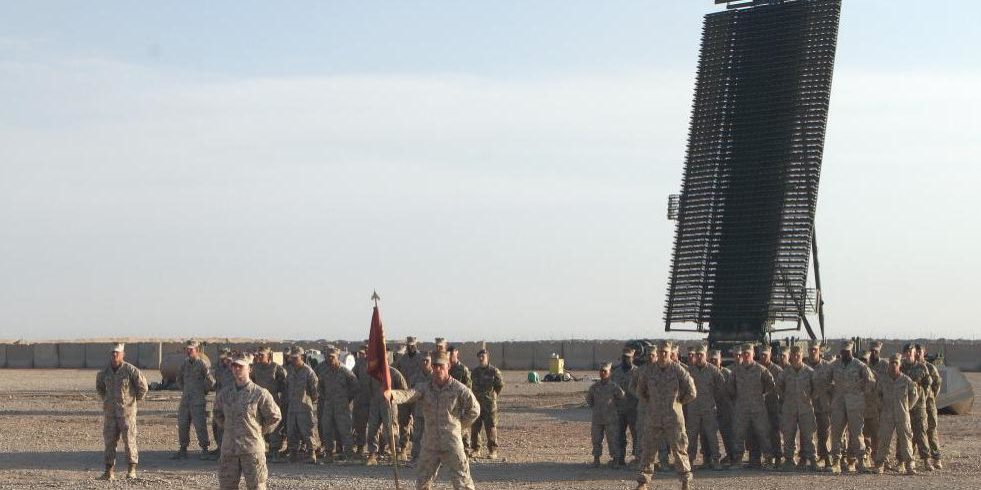Quick Facts
| Role and Mobility | Long-Range Air Surveillance, Ground-Control Interception; Road-mobile, Air-mobile |
| Frequency | L-Band |
| Range | 740 km |
| Air Defense Interceptor Systems | HAWK and Patriot Missile Systems |
| Targets | Theater Ballistic Missiles and Cruise Missiles |
| Status/Exports | Operational; Egypt and Bahrain |
| Producer | Lockheed Martin |
Overview
The AN/TPS-59 is a lightweight, air- and road-transportable, solid-state, three-dimensional air defense radar which provides long-range surveillance and ground-control intercept (GCI) capability in a tactically mobile environment.[i] GCI is an air defense tactic whereby one or more radar stations are linked to a command communications center which guides interceptors to targets. The radar primarily exists in a support role at the Marine Corps Communications and Electronics School (MCCES), the Marine Corps Tactical Systems Support Activity (MCTSSA), and the Marine Corps Logistics Base (MCLB), Barstow.[ii] More notable is the upgraded version, the AN/TPS-59 Version 3. Developed for the United States Marine Corps, the AN/TPS-59(V)3 is designed to detect and track theater ballistic missiles and cruise missiles with a range of up to 740 km and an altitude of 500,000 feet.[iii] The radar can be integrated with multiple weapon systems including HAWK and Patriot air defense systems. It can also be integrated with other sensors to improve launch and impact point prediction, offer extended range capabilities, and demonstrate cooperative engagement.[iv]
Strategic Implications
The AN/TPS-59 and AN/TPS-59(V)3 radars are strategically valuable as it can be rapidly transported by trucks on the ground and helicopters or cargo planes in the air, allowing it to be deployed in whatever area needs it most.[v] By itself, the AN/TPS-59(V)3 radar can detect and track incoming targets, but when paired with HAWK, it becomes the most cost effective theater missile defense system currently in operation for US allies with successful performances against ballistic missiles and air breathing threats.[vi] Its range and 360 degree scanning capabilities provide the deploying country a surveillance volume of 603 million km^3 ensuring exceptional coverage in tactical missile defense. Most importantly, the AN/TPS-59(V)3 radar system is currently the only fielded ground-based sensor that can detect and track long range Air Breathing Targets (ABT) and Tactical Ballistic Missiles (TBM) giving the United States an unmistakable field advantage.[vii] These radars increase alert time for military and civilian personnel and increase the defended footprint.[viii]
Recent News
Timeline
August 2017: Lockheed Martin Receives Contract for Upgrades to the AN/TPS-59(V)3
June 2014: Lockheed Martin Provides Array Electronics for the AN/TPS-59(V)3 Radar
October 2007: Bahrain Takes Delivery of AN/TPS-59 Missile Defense Radar
August 1996: The AN/TPS-59(V)3/HAWK Integrated System Completed a Live Fire Test Program
1992: Lockheed Martin was Contracted to Create the AN/TPS-59(V)3
1982: The AN/TPS-59 Radar Reaches Operational Capability
References
[i] http://www.deagel.com/Sensor-Systems/ANTPS-59_a001373001.aspx
[ii] https://www.globalsecurity.org/space/systems/an-tps-59-specs.htm
[iii] https://www.lockheedmartin.com/content/dam/lockheed/data/ms2/documents/ground-based-air-surveillance/TPS-59%20Fact%20Sheet.pdf
[iv] http://www.deagel.com/Sensor-Systems/ANTPS-59_a001373001.aspx
[v] http://www.radartutorial.eu/19.kartei/02.surv/karte019.en.html
[vi] Ibid.
[vii] https://www.globalsecurity.org/space/systems/an-tps-59.htm

